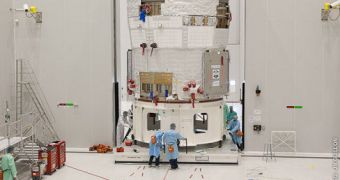Representatives from the European Space Agency (ESA) announce that the next Automated Transfer Vehicle (ATV) is now loaded and ready to launch. The spacecraft is the third unmanned space capsule that the organization constructs for resupplying the International Space Station (ISS).
Dubbed Edoardo Amaldi, ATV-3 follows in the footsteps of the first two spacecraft in the series, called Jules Verne and Johannes Kepler. The latest capsule is named after 20th-century physicist Edoardo Amaldi, the co-founder of the Italian National Institute for Nuclear Physics, CERN and ESRO.
The spacecraft bearing his name is now ready for its March 9 launch date, from the Kourou Spaceport, in French Guiana, South America. Takeoff is scheduled to occur at 1000 GMT (11:00 CET), aboard an Ariane 5 ES delivery system.
According to current plans, the capsule will spend about 10 days in orbit chasing after the ISS. It's scheduled to reach the orbital outpost on March 19, at around 0138 GMT (02:38 CET). After completing resupply operations, it will be discarded sometime in August.
Like all other ATV before it, Edoardo Amaldi will reenter Earth's atmosphere, break up high above the surface, and then burn on its way down. It will deliver about 10 tons of supplies to the ISS, including food, water, oxygen, fuel and spare parts.
After astronauts finish unloading and storing all the supplies, they will fill the capsule with garbage and other items that are no longer needed. All of them will be incinerated in the atmosphere, and destroyed.
An estimated 535 kilograms (1,179.s pounds) of last-minute items are currently being lowered into the ATV via its main hatch. This is a very complicated and delicate procedure, which is bound to take up the rest of the month.
ESA officials are very pleased with the way the spacecraft was assembled and integrated. “By end-August, we had moved both halves into their respective cleanrooms here and started checking that everything was OK after the sea journey,” Charlotte Beskow says.
The ESA ATV deputy launch campaign manager adds that “September and October were spent checking systems, preparing the loading of dry cargo arriving from Europe and NASA, and integrating final components such as the folding solar panels that had been shipped disassembled.”

 14 DAY TRIAL //
14 DAY TRIAL //